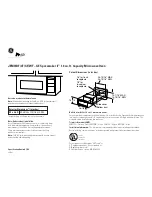
normal sockets to avoid overloading and causing fire.
5. The microwave oven for home heating and cooking food and design, please do not
use for industrial and commercial.
6. Do not cover the ventilation openings to avoid damage to the oven because of the
over-temperature.
7. WARNING: Liquids and other foods must not be heated in sealed containers since
they are liable explode.
8. To reduce the risk of fire in the oven cavity:
a. Do not heat food in sealed
,
and do not overcook the food.
b. When heating food in plastic or paper containers, keep an eye on the oven due
to the possibility of ignition.
c. Do not heat oil or fat for deep drying as the temperature of oil can not be
controlled.
d. After use wipe the waveguide cover with a damp cloth, followed by dry cloth to
remove any food splashes and grease. Built-up grease may overheat and
begin to cause smoke or catch fire
e. If smoke is observed, switch off or unplug the appliance and keep the door
closed in order to stifle any flames.
f. Close supervision is necessary when using any one-off containers made from
plastic, paper or other combustible material.
g. When cooking the food with less moisture content or not heat-resistant
container, please use low power to avoid burning.
9. To reduce the risk of explosion and sudden boiling:
a. Do not place sealed containers in the oven. Baby bottles fitted with a screw
cap or teat are considered to be sealed containers.
b. When boiling liquid in the oven, use the wide-mouthed container and food at
the top of the container must stay away enough space from the mouth to
avoid the food spilled boiling.
c. Potatoes, sausage and chestnut should be peeled or pierced before cooking.
d. Microwave heating of beverages can result in delayed eruptive boiling,
therefore care must be taken when handing the container.
e. The contents of feeding bottles and baby food jars shall be stirred or shaken
and the temperature checked before consumption, in order to avoid burns.
f. Eggs in their shell and whole hard-boiled eggs should not be heated in
microwave ovens since they may explode, even after microwave heating has
ended.
10. WARNING: If the door seals are damaged, the oven must not be operated until it
has been repaired by a competent person.
11. If the supply cord is damaged it must be replaced by the manufacturer or its
service agent or a qualified technician in order to avoid a shock hazard.
12. After cooking, the container is very hot. Using gloves to take out the food and
avoid steam burns by directing steam away from the face and hands.
13. Slowly lift the furthest edge of dishes cover and microwave plastic wrap and
carefully open popcorn and oven cooking bags away from the face and hands.
14. To prevent the turntable from breaking:
a. Let the turntable cool down before cleaning.
b. Do not place hot foods or utensils on the cold turntable.
c. Do not place frozen foods or utensils on the hot turntable.
d. Make sure the utensils and turntable do not touch the interior walls during
working.
15. Do not store food or any other things inside the oven.
16. Do not operate the oven without any liquid or food inside the oven. Operate
without anything would do damage the oven.
17. WARNING: Only allow children to use the oven without supervision when
2




































